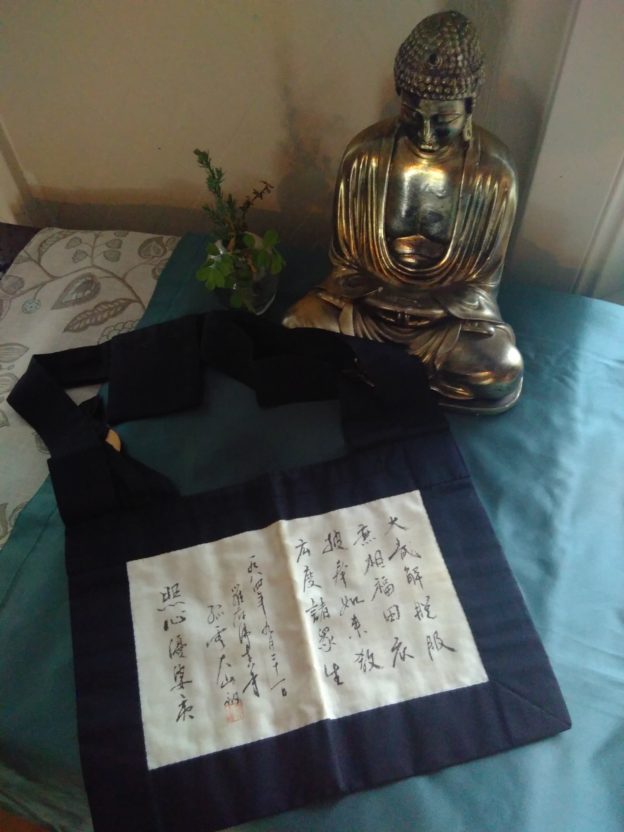I received the precepts from Maezumi Roshi in London sometime in the early 1980s. Sumi Komo took a photograph as I was given my rakusu. Isshin is in the picture! I look very serious, and very young. And I had very little idea what it all meant. I am sure you never do with occasions like this. The point is to find out as you go along.
I was very new to the practice. Chris and I had been sitting for only a few months, with a group Sumi and Colin Egan were getting together in South London. They wanted to help establish White Plum Asanga in Britain. Maezumi Roshi’s visit to London was part of that work. I think it was Sumi who suggested we receive Jukai.
The precepts were not a big part of practice at that time. Genpo Sensei came across to hold sesshins, and the practice revolved around his style and teachings. Genpo wasn’t particularly focussed on the precepts.
We left London in 1989 and moved to Edinburgh. After a while we became members of a Soto group affiliated to Shasta Abbey and the Rev. Jiyu Kennett. The centre for the Edinburgh group was Throssel Hole Abbey in Northumberland. The precepts were a much more important part of practice then. The Edinburgh group established a small priory in Portobello, down the road from where we lived. The resident monk held monthly renewal of the precepts ceremonies. The precepts were an important part of introductions for newcomers who wanted to find out about the practice. We told them, “In Buddhism, you are punished by, not for, failing to keep the precepts”.
And so I was made to think about what the precepts meant. I came to realise what a task that is. Each precept may look straightforward but has room for many interpretations. You have to pick the interpretation appropriate to you and work with it. It is not easy. For example, “Refrain from using intoxicants” looks simple, but there are many ways of being intoxicated. Hiding behind noble pursuits is of little use. For example, I reluctantly have to admit that you can be addicted to skiing in ways that are harmful both to yourself and people close to you. Even sitting can be an intoxicant and get in the way of your life.
I thought I had cracked the precept about “not gossiping” when a colleague, during an idle lunchtime chat about the failings of absent bosses, said “We won’t ask Guro. She doesn’t gossip.” But how do you differentiate “gossip” from examining the behaviour of others in order to find out how to respond to the harm it is causing? That line is not always easy to draw.
The precepts have become central to practice, which to me is balancing on an edge between possibilities of yes and no. The edge shifts continually as you have to revise your interpretations of right and wrong, appropriate and inappropriate. It is hard work to keep the balance. I keep falling off the perch. The precepts often help me get back on.
If the precepts are an ephemeral part of Jukai, not easy to grasp, then a far more tangible outcome of the ceremony with Maezumi Roshi is my rakusu. I made it myself. He wrote the verse of the kesa on the white panel in his elegant kanjis. He made a gift of my dharma name, together with the line of successors, also in kanjis. I have come to realise what a remarkable man he was and my appreciation of my rakusu has grown in proportion. It is a constant, to which I always return when my practice waivers or I go off track. It is also a fixed point for explorations of new territories of practice.
Chris and I were lay ministers in the Edinburgh sangha for a while. We learned a lot from being lay ministers, and I am grateful for that opportunity. We left however. The role of lay ministers did not sit easily with us after a while. We were supposed to be a visible sign of continuous and long-term commitment to practise with that tradition, but there were other sangha members whom we thought fulfilled that role better than us. And anyway, we were moving to Norway.
We were given new lay minister rakusus, in shiny green material. They just weren’t the same. Returning to my plain, black, well-worn rakusu with Maezumi’s kanjis was like coming home.

